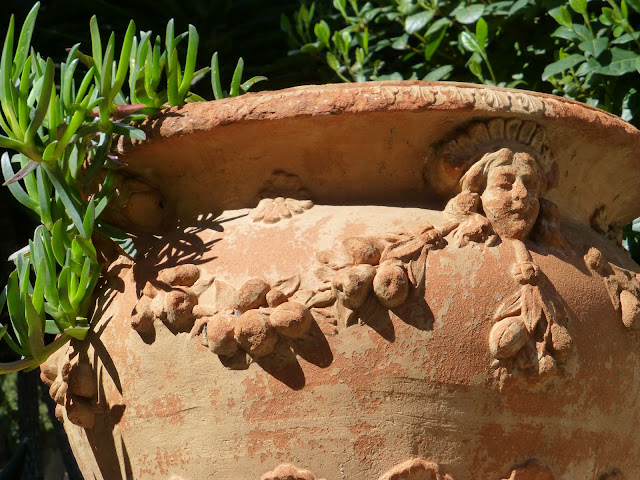It is the villa Les Palmiers, home of the municipal archives of Nice.
The records themselves have moved around a lot. To start with in 1204, the city archives were conserved in the sacristy of the Cathedrale Sainte-Maire of the "chateau", then moved to the municipal "common house", then transferred to "Place Saint-Francois" in 1508. From 1890-1928 they were housed in the annex of the municipal library and next integrated in the Villa Massena.
Finally en 1965 they were moved to the current "Palais de Marbre" or the Villa les Palmiers built in 1840 by banker Gastaud Honore at lower Fabron .
The trees and park of the present villa date from this period too and used to contain "rooms" decorated with rocaille, fake cliffs , artificial caves and a conservatory. Traces of these original gardens still exist today but are completely hidden from the street.
 |
| Photo by John Puckett |
 |
| Photo by John Puckett |
In 1858, during a stay on the Riviera, the Tsarina Alexandra Feodorovna asked to visit the gardens famous for their species. And in this villa Napoleon III and the Empress Eugenie were housed during the festivities of the annexation of the County of Nice to France.
In 1871 the consul Ernest Gambard acquired the property from the bankrupt former owner to further "re-make" the palace. He commissioned the architect Sebastian Biasini to build a sumptuous exhibition and reception gallery to be covered entirely of Carrara marble. A verse by John Keats can be seen engraved on the south facade to summarize the scope of the project :"A thing of beauty is a joy to behold".
After the death of the Gambard in 1902, the villa was sold to Russian Baron Alexander von Falzfein who changed it once more. And in 1925, a new owner Edward Soulas, made the palace into a luxurious brothel. But when brothels were outlawed, the palace stood abandoned for many years.
In 1956, the entire estate was sold to a real estate company that built around it the current dispiriting residential apartments. The park and villa, though, were sold to the city and now the villa is used for the municipal archives.
So, what's in there, really?
There are a number of the city's important papers, judicial mainly, but also administrative and religious. And the archives include almanacs and "annuaires" from the 19th and 20th centuries in French and Italian.
But I don't have any use for these and have only glimpsed the huge tomes through the windows. One day, though, I will go in and see if they have a book of engravings of the Italianate friezes in the area.
What I like to visit are the vestiges of the hidden gardens that still hold a whiff of another century. One can imagine ladies in long gowns strolling around the grounds with their parasols well sprung against the Mediterranean sun.
What I like to visit are the vestiges of the hidden gardens that still hold a whiff of another century. One can imagine ladies in long gowns strolling around the grounds with their parasols well sprung against the Mediterranean sun.
 |
| Archive building, photo by John Puckett |
 |
| Photo by John Puckett |
 |
| Photo by John Puckett |
 |
| Photo by John Puckett |
 |
| Photo by John Puckett |
 |
| Photo by Mary Payne |
 |
| Photo by John Puckett |

No comments:
Post a Comment